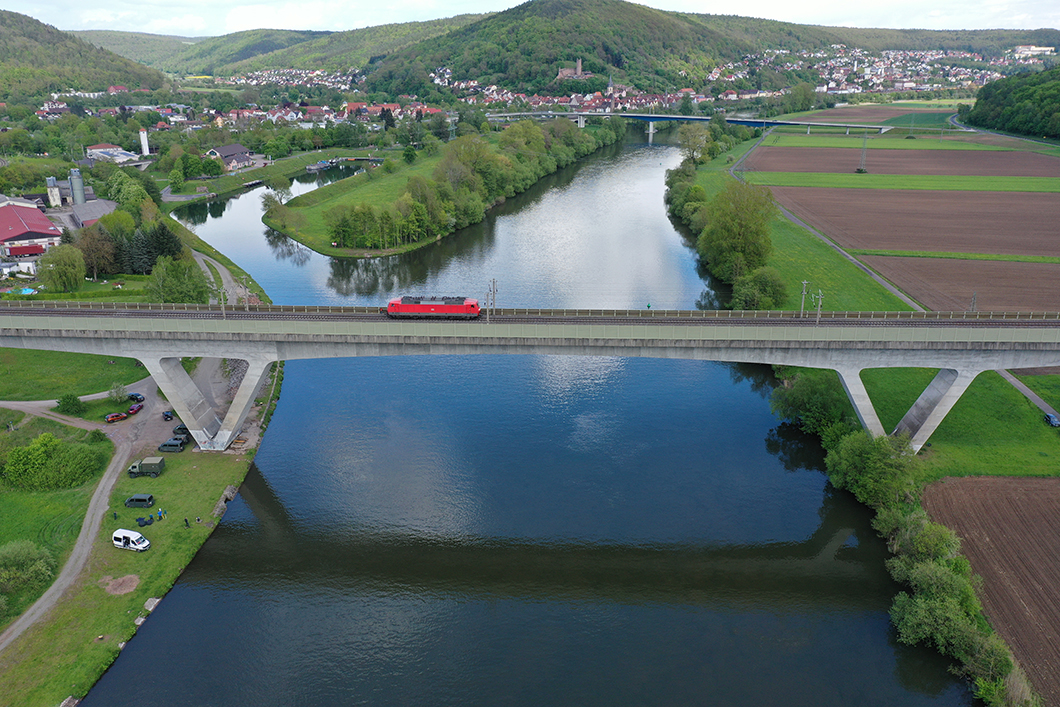
The sensor-based monitoring system was installed on a bridge over the river Main near Gemünden and tested during a load test with an 85-tonne electric locomotive: 82 sensors recorded deformations, strains, vibrations, and temperatures of the structure.
Source: Bauhaus-Universität Weimar, Florian Madeya
There are tens of thousands of bridges in Germany. Most of them are still manually checked for safety - which is expensive and inflexible. The Bundesanstalt für Materialforschung und -prüfung (BAM) has now developed a sensor-based monitoring system that allows continuous remote monitoring of bridges and even enables predictive maintenance. The practicability of the system was successfully tested on a large bridge over the river Main in Bavaria.
Bridges in Germany are checked for safety every three to six years. The structures are visually inspected, and the findings and their assessments are documented manually in databases and logbooks. On this basis, experts decide whether a bridge needs to be repaired or even closed to traffic for a longer period. The Deutsche Bahn AG, for example, applies this largely analogue approach to manage approximately 26,000 railway bridges.
"The condition monitoring and assessment of bridges and other engineering structures should be digitized in the future and improved using more efficient concepts," explains Ronald Schneider, an expert in structural integrity management at BAM. "Ideally, monitoring should also allow for predictive maintenance so that inspections and maintenance actions can be optimally planned. If damage processes are detected at an early stage, the risk of bridge closures with their far-reaching societal consequences can also be reduced."
Schneider and his colleagues have developed a completely digital solution for this purpose. It enables the automatic monitoring of bridges based on sensor data. The Bauhaus University Weimar (BUW), DB Netz AG and the engineering consultancy Leonhardt, Andrä und Partner (LAP) were partners in the three-year project.
The structural health monitoring system continuously monitors the condition of a bridge: Permanently installed sensors continually provide data. By evaluating them with special algorithms, damage can be identified automatically and quickly. In this way, structural inspections can be initiated on demand and beyond fixed time intervals.
In future, they will no longer have to be carried out on site. In addition to BAM's monitoring system, the Bauhaus-Universität Weimar has developed a method in which drones record high-resolution images of the structure. Artificial intelligence is used to detect damage such as cracks or spalling of the concrete.
The drone images are also used to produce a three-dimensional model of the building. Different experts can view it simultaneously from different locations in a virtual reality environment and assess the damage without having to be on site.
BAM's sensor-based monitoring system even allows a look into the future: it makes it possible to predict future defects by linking the sensor data with prognostic models of the relevant damage processes.
BAM and its project partners have tested the innovative system on an almost 800-metre-long railway bridge spanning the River Main near Gemünden in Bavaria. The team installed a total of 82 sensors on the structure.
Over the course of two days, the experts let an electric locomotive weighing almost 85 tons drive over the bridge to measure deformations of the undamaged structure and to calibrate a digital model of the bridge. "Based on this calibrated model of the bridge, we can now simulate virtual damages and reactions of the structure," says Ronald Schneider. "In case of deviations from the expected data, an alarm would be triggered, possible damage could be detected and repaired before it reaches a critical extent."
The joint research project was funded by the Federal Ministry of Education and Research.


